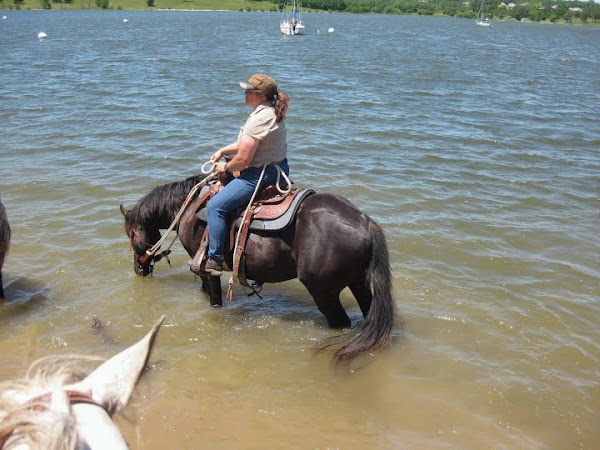“I can’t take him to group trail rides.”
Peter pauses as he rides by. “Why not.”
“He sees another horse disappear around a corner in front of him and he just goes apey.”
Peter considers briefly. “Okay.” And rides on.
I watch him go. I knew he had an answer for me beyond “you have to keep him from leaving you mentally.” I got that part. What I didn’t know was how. It was going to be my responsibility to help my horse, not expect him to help me.
Allowing others to fill in for me has become a habit. Learning to ask for help at all is an acquired taste and then to keep it in the middle has become a challenge. Refuse to let anyone in or lean on them too much, I have run into that before in life. Partnership is a much easier word to say than a lifestyle to practice.
In the warm up for the Foundation class, we check out the stuff we have learned. “Be smooth,” Peter says. “See how little it takes.”
Then he introduces another exercise. Take the horse under the halter by the fiador knot and lead him around you in a half circle. Roll the hindquarters over, back a couple steps and release.
Everything should operate lightly, the forward motion, the stepping over of the hind. The horse should bridle up, softening at the poll and step back freely and the release should be a natural part of the evolution.
I have been working with Royal to come forward nicer. One hand on each side of his face, taking hold of the knots on the halter. Once the forward happens, you bend the head, neck and the body should arc around, still coming with you. Saying no to forward is as apt to be an answer from my pony as rushing off. Two sides of the same coin.
Peter is helping one of the gals with her silver and white gaited mare. “When these things won’t work with you, you can’t have it. Get them to work with you, you can’t beat it.”
The mare doesn’t want to come forward, she doesn’t want to line her hindquarters flat to the rail. She doesn’t really think she has to do much of anything she does not want to do. Before the day is over, she will have different thoughts and where a horse stands, all awkward sharp pointy angles and brace, an animal appears of sheer magical beauty, round, soft and gracious. I will see things today that will forever iron down my faith in Peter, who he is and what he does.
“How many of you have heard tough times build character?” He asks us for a show of hands, and most of us raise ours.
“I don’t believe that, not for a moment.” Pause. Looks at us to see if we are listening.
“What tough times do is reveal the true nature of the character that is already there.”
I see that lean man astride his horse like he was born a part of it and I know he has been tried and not found wanting.
We have spoke this weekend how when things go well, people tend puff up, rub themselves on the back as to what a fine hand they are. When they go wrong, it’s Peter’s fault.
Drawing lines in the sand and setting things in concrete is something I have become very wary of. I used to be proud when someone called me a hard head because it meant I wasn’t falling over for any little breeze coming down the pike, not taken in by your friendly neighborhood snake oil salesman.
I have since found out this much like any other, working against me, I can’t have it, working for me, can’t beat it but finding the balance to turn defect to attribute is as always, the trick.
Here’s my line in the sand. If you think you have something poor to think or say about Peter Campbell, find a different place to do it than anywhere around me. This is not a challenge to start that conversation. It’s solid advice to not. That’s in concrete.
“If I were to write another book on horsemanship,” Peter says, “It would go like this:
Observe, remember, compare.
Encourage, discourage. Rearrange the life in the feet.
Feel, timing and balance.
The End.”
Rearrange the life in the feet. I observe my horse, I see a couple bracey spots when I ask for this thing, or that. I practice moving this foot, being particular but not critical. No, not that foot, Royal, this one. I try to see what happens when I place pressure a certain way, how he interprets that against what I meant to have happen.
Encourage, discourage, direct what happens. If it has already taken place, you are punishing whatever the horse is doing at the moment not what he just did. What’s done is done. Don’t blame him for your poor timing.
The half circle forward begins to glide. I watch for when his outside front foot steps over, readying the inside hind to come off the ground. When I don’t think about it, feel it in the moment, I ask my horse to roll over behind. He does and steps back in one fluid motion. I release and smile. That feels wonderful.
This is what you do before things go south. This is HOW to rearrange the life in the feet to keep the horse from leaving you mentally.
Later this afternoon, I get a chance to practice that very thing.
** You will have to forgive (or not) my lapse if I post photos from the wrong days or quote Peter on Saturday for something he said on Friday. It’s all one blissful blur at this point but you will get the gist
















No comments:
Post a Comment